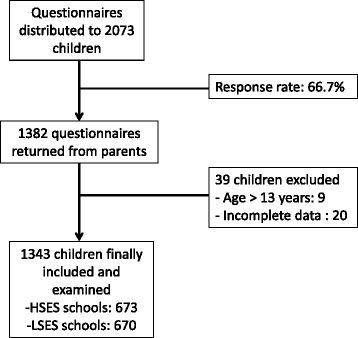Overweight and obesity in children aged 3-13 years in urban Cameroon: a cross-sectional study of prevalence and association with socio-economic status
- PMID: 28163924
- PMCID: PMC5286775
- DOI: 10.1186/s40608-017-0146-4
Overweight and obesity in children aged 3-13 years in urban Cameroon: a cross-sectional study of prevalence and association with socio-economic status
Abstract
Background: Childhood overweight/obesity is increasing rapidly in developing countries. There is a need to provide more evidence on its burden in sub-Saharan Africa, and to identify associated factors in order to set preventive measures. We aimed to determine the prevalence of overweight/obesity and assess its association with the socioeconomic status in nursery and primary school children in urban Cameroon.
Methods: In this cross-sectional study, we included by multi-staged cluster random sampling 1343 children from high (HSES, n = 673) and low (LSES, n = 670) socioeconomic status schools in Douala. Parent/child demographic data were collected, and children's anthropometric parameters were measured using validated methods. The World Health Organization body mass index-for-age reference curves were used.
Results: The prevalence of overweight/obesity was 12.5% (13.2% in girls, 11.8% in boys). The risk of overweight/obesity was 2.40 (95% CI 1.70, 3.40) higher in HSES children compared to LSES after adjusting for age and gender. However this association was attenuated to 1.18 (95% CI 0.59, 2.35) once adjustment had been made for a range of potential confounders.
Conclusions: Overweight/obesity is relatively common in sub-Saharan African children and prevalence is associated with HSES. However, this association may be mediated by sweet drink consumption, passive means of travel to school and not doing sport at school. We suggest that these potentially modifiable behaviors may be effective targets for obesity prevention. Further studies should specifically focus on unhealthy behaviors that mediate overweight/obesity as well as other non communicable diseases in children.
Keywords: Adolescent; Cameroon; Children; Obesity; Overweight; Prevalence; Socioeconomic status.
Figures
Similar articles
-
A study of growth parameters and prevalence of overweight and obesity in school children from delhi.Indian Pediatr. 2006 Nov;43(11):943-52. Indian Pediatr. 2006. PMID: 17151397
-
The determinants of overweight and obesity among 10- to 15-year-old schoolchildren in the North West Province, South Africa - the THUSA BANA (Transition and Health during Urbanisation of South Africans; BANA, children) study.Public Health Nutr. 2006 May;9(3):351-8. doi: 10.1079/phn2006849. Public Health Nutr. 2006. PMID: 16684387
-
Prevalence and factors associated with overweight and obesity among private kindergarten school children in Bahirdar Town, Northwest Ethiopia: cross-sectional study.BMC Res Notes. 2017 Jan 4;10(1):22. doi: 10.1186/s13104-016-2308-8. BMC Res Notes. 2017. PMID: 28057042 Free PMC article.
-
Contribution of Home and School Environment in Children's Food Choice and Overweight/Obesity Prevalence in African Context: Evidence for Creating Enabling Healthful Food Environment.Pediatric Health Med Ther. 2020 Aug 24;11:283-295. doi: 10.2147/PHMT.S257549. eCollection 2020. Pediatric Health Med Ther. 2020. PMID: 32922118 Free PMC article. Review.
-
Prevalence of overweight and obesity among African primary school learners: a systematic review and meta-analysis.Obes Sci Pract. 2019 Aug 20;5(5):487-502. doi: 10.1002/osp4.355. eCollection 2019 Oct. Obes Sci Pract. 2019. PMID: 31687173 Free PMC article. Review.
Cited by
-
Nutritional status of school children in the South Tongu District, Ghana.PLoS One. 2022 Aug 24;17(8):e0269718. doi: 10.1371/journal.pone.0269718. eCollection 2022. PLoS One. 2022. PMID: 36001627 Free PMC article.
-
Wealth and obesity in pre-adolescents and their guardians: A first step in explaining non-communicable disease-related behaviour in two areas of Nairobi City County.PLOS Glob Public Health. 2023 Feb 28;3(2):e0000331. doi: 10.1371/journal.pgph.0000331. eCollection 2023. PLOS Glob Public Health. 2023. PMID: 36962946 Free PMC article.
-
Relationship between childhood obesity and socio-economic status among primary school children in Costa Rica.Public Health Nutr. 2021 Aug;24(12):3825-3833. doi: 10.1017/S1368980021002032. Epub 2021 May 12. Public Health Nutr. 2021. PMID: 33975662 Free PMC article.
-
Shared correlates of maternal and childhood overweight in Cameroon: a cross-sectional analysis of demographic and health survey data.BMC Public Health. 2023 Jun 29;23(1):1265. doi: 10.1186/s12889-023-16164-y. BMC Public Health. 2023. PMID: 37386386 Free PMC article.
-
Global relationship between parent and child obesity: a systematic review and meta-analysis.Clin Exp Pediatr. 2022 Jan;65(1):35-46. doi: 10.3345/cep.2020.01620. Epub 2021 Mar 29. Clin Exp Pediatr. 2022. PMID: 33781054 Free PMC article.
References
-
- World Bank . The global burden of disease: main findings for Sub-Saharan Africa. 2013.
-
- Fetuga MB, Ogunlesi TA, Adekanmbi AF, Alabi AD. Nutritional status of semi-urban Nigerian school children using the 2007 WHO reference population. West Afr J Med. 2011;30(5):331–6. - PubMed
LinkOut - more resources
Full Text Sources
Other Literature Sources


